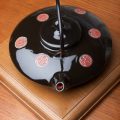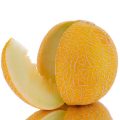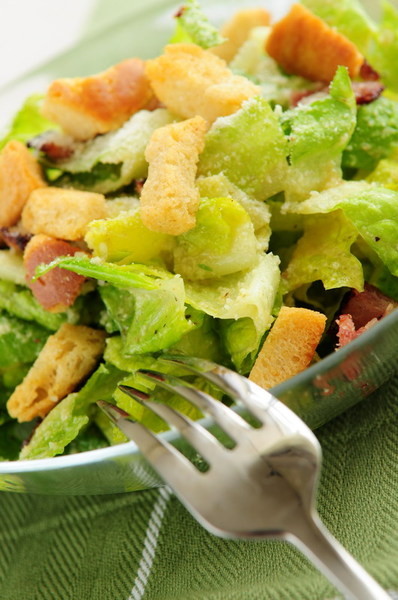 Caesar salad classic recipe In the distant 1896year near the town of Lago Maggiore, in Italy, a boy was born, who was named Caesar. Not Gay Yulia, of course, but simply Caesar, with the simple Italian name Cardini. After World War I, he and his brother Alex emigrated to the United States, where he opened a small institution combining a hotel and a restaurant, called "Caesar's Place", which can easily be translated as "U Caesar". More precisely, Cardini opened this institution not in the States themselves, but in Mexico, in the town of Tijuana, 20 miles from the city of San Diego, in which he lived. Such a geographical position of things made it possible to have a profitable business bypassing the dry law that was "raging" then in the USA. On one of the Days of Independence, namely on July 4, 1924, the Cardini establishment was occupied by Hollywood stars who crossed the border for the sole purpose of having a good drink. Actually, with drinking "Caesar's" problems were not, but with snacks, things were problematic: all decent stocks were over, and the closest stores were completely closed. All that remained with Caesar was eggs, olive oil, lettuce leaves, bread, Worcester sauce, Parmesan cheese, garlic. To somehow correct his hindsight, Cardini mixed what was, and offered IT to the guests. So the world saw the first salad, which was later named after the inventor, and came to full delight. This is the canonical version of the appearance of the Caesar salad in the light of God, first told by Cardinal's daughter Rosa. Later this story appeared in such respected sources as the Chicago Tribune (July 23, 1987), The Santa Fe New Mexican (May 28, 1997), Tulsa World (July 9, 1997) and many others, having by then acquired with rumors and conjectures. It was said, for example, that among the first lucky ones who tried the product of the great restaurateur were Clark Gable and Jean Harlow. Although in fact it was not, because it could not be: in 1924 Gable was still young and unknown, and Gene Harlow was at all 13 years old. The only person who claims that Caesar was at that historic day and ate a new dish was Julia Child, who was brought with her parents. Julia Childe subsequently became a well-known author of cookbooks.
Caesar salad classic recipe In the distant 1896year near the town of Lago Maggiore, in Italy, a boy was born, who was named Caesar. Not Gay Yulia, of course, but simply Caesar, with the simple Italian name Cardini. After World War I, he and his brother Alex emigrated to the United States, where he opened a small institution combining a hotel and a restaurant, called "Caesar's Place", which can easily be translated as "U Caesar". More precisely, Cardini opened this institution not in the States themselves, but in Mexico, in the town of Tijuana, 20 miles from the city of San Diego, in which he lived. Such a geographical position of things made it possible to have a profitable business bypassing the dry law that was "raging" then in the USA. On one of the Days of Independence, namely on July 4, 1924, the Cardini establishment was occupied by Hollywood stars who crossed the border for the sole purpose of having a good drink. Actually, with drinking "Caesar's" problems were not, but with snacks, things were problematic: all decent stocks were over, and the closest stores were completely closed. All that remained with Caesar was eggs, olive oil, lettuce leaves, bread, Worcester sauce, Parmesan cheese, garlic. To somehow correct his hindsight, Cardini mixed what was, and offered IT to the guests. So the world saw the first salad, which was later named after the inventor, and came to full delight. This is the canonical version of the appearance of the Caesar salad in the light of God, first told by Cardinal's daughter Rosa. Later this story appeared in such respected sources as the Chicago Tribune (July 23, 1987), The Santa Fe New Mexican (May 28, 1997), Tulsa World (July 9, 1997) and many others, having by then acquired with rumors and conjectures. It was said, for example, that among the first lucky ones who tried the product of the great restaurateur were Clark Gable and Jean Harlow. Although in fact it was not, because it could not be: in 1924 Gable was still young and unknown, and Gene Harlow was at all 13 years old. The only person who claims that Caesar was at that historic day and ate a new dish was Julia Child, who was brought with her parents. Julia Childe subsequently became a well-known author of cookbooks.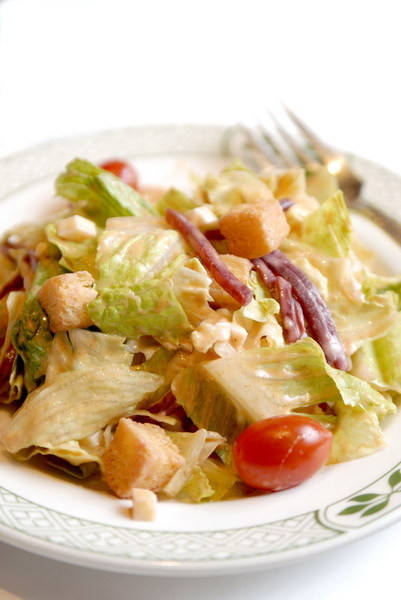 So what exactly did Caesar feed the hota crowd of filmmakers? After touching several options in his mind, Cardini chose, as is now clear, the only true one. He rubbed a plate of garlic on it, laid salad leaves on it, poured oil on it, smashed the eggs cooked in a special way (namely, the eggs were dropped into boiling water for exactly 60 seconds, while the water itself did not boil, resulting in egg consistency as a good dressing ), added grated cheese, lemon juice, seasonings and croutons made with olive oil and garlic. All! No anchovies, no matter what other ingredients in the classic salad was. As for the anchovies, Caesar's brother Alex Cardini, who left the service of a military pilot, joined the restaurant business of his brother in 1926-27. He added anchovies to the salad when he treated them to American pilots from San Diego, and called this variation "Aviator's Salad". Caesar himself very negatively perceived anchovy innovation, he said that the Worchester sauce is enough to make the salad have a piquant taste. Also Caesar claimed that a real salad should be prepared only with Italian olive oil and Italian parmesan. There is a version that Alex Cardini shortly before his death in 1975 met with Diane Kennedy in Mexico City, which he told about his salad. Diana became interested in the culinary details of this dish, and thanks to her, it was a misunderstanding that the classic Caesar salad should include anchovies. One of the "scandalous" versions of the birth of the famous salad was told by journalist Neal Mathews from the pages of his newspaper "San Diego Union-Tribune" (March 2, 1995). He told about a certain Livio Santini, the old Tijuana, who claims that it was he, Livio, who created this salad according to his mother's recipe when he worked in the kitchen of Caesar's restaurant at the age of 18. And already supposedly directly from him Cardini took over the recipe and "appropriated" the invention to himself. To believe this story as many reasons as not to believe, especially given the popularity that the salad had by 1995. The author of another, highly controversial version is George Leonard Hurter, who wrote in his book Bull Cook and Authenti Historical Recipes and Practices that the Caesar salad was first prepared in 1903 by Giacomo Junia, an Italian chef in Chicago. "Giacomo was the chef of a small restaurant called The New York Cafe, and tried to please American tastes, because popular in Italy, spaghetti and pizza were practically not in demand except for the Italians themselves ... Then it was invented a salad that Giacomo called "Caesar", in honor of the greatest Caesar Italian - Guy Julia ... The salad itself consisted of leaves of romaine lettuce ... Jounie did not even suspect that his salad would become extremely popular. Many cooks-travelers were interested in his recipe, and soon "Caesar" spread not only throughout North America, but even in Europe. "
So what exactly did Caesar feed the hota crowd of filmmakers? After touching several options in his mind, Cardini chose, as is now clear, the only true one. He rubbed a plate of garlic on it, laid salad leaves on it, poured oil on it, smashed the eggs cooked in a special way (namely, the eggs were dropped into boiling water for exactly 60 seconds, while the water itself did not boil, resulting in egg consistency as a good dressing ), added grated cheese, lemon juice, seasonings and croutons made with olive oil and garlic. All! No anchovies, no matter what other ingredients in the classic salad was. As for the anchovies, Caesar's brother Alex Cardini, who left the service of a military pilot, joined the restaurant business of his brother in 1926-27. He added anchovies to the salad when he treated them to American pilots from San Diego, and called this variation "Aviator's Salad". Caesar himself very negatively perceived anchovy innovation, he said that the Worchester sauce is enough to make the salad have a piquant taste. Also Caesar claimed that a real salad should be prepared only with Italian olive oil and Italian parmesan. There is a version that Alex Cardini shortly before his death in 1975 met with Diane Kennedy in Mexico City, which he told about his salad. Diana became interested in the culinary details of this dish, and thanks to her, it was a misunderstanding that the classic Caesar salad should include anchovies. One of the "scandalous" versions of the birth of the famous salad was told by journalist Neal Mathews from the pages of his newspaper "San Diego Union-Tribune" (March 2, 1995). He told about a certain Livio Santini, the old Tijuana, who claims that it was he, Livio, who created this salad according to his mother's recipe when he worked in the kitchen of Caesar's restaurant at the age of 18. And already supposedly directly from him Cardini took over the recipe and "appropriated" the invention to himself. To believe this story as many reasons as not to believe, especially given the popularity that the salad had by 1995. The author of another, highly controversial version is George Leonard Hurter, who wrote in his book Bull Cook and Authenti Historical Recipes and Practices that the Caesar salad was first prepared in 1903 by Giacomo Junia, an Italian chef in Chicago. "Giacomo was the chef of a small restaurant called The New York Cafe, and tried to please American tastes, because popular in Italy, spaghetti and pizza were practically not in demand except for the Italians themselves ... Then it was invented a salad that Giacomo called "Caesar", in honor of the greatest Caesar Italian - Guy Julia ... The salad itself consisted of leaves of romaine lettuce ... Jounie did not even suspect that his salad would become extremely popular. Many cooks-travelers were interested in his recipe, and soon "Caesar" spread not only throughout North America, but even in Europe. " 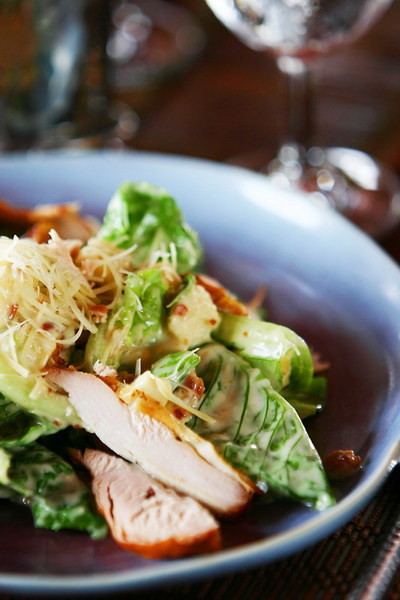 Nevertheless, no matter what they say about the realroots of Caesar salad, but it was Caesar Cardini's salad that got the greatest fame. His salad became a dish, for which specifically came to Tijuana. The European debut of "Caesar" took place thanks to the wife of Prince Edward VIII of Wales. The princess traveled extensively, including San Diego and Tijuana in the 1920s, and was a passionate fan of Cardini's salad. They say that it was in this area that she met her future husband. There is another legend (and perhaps not a legend) associated with the princess and the salad. Initially, Cardini served whole leaves of the salad, he was taken from the plate with his fingers, the princess was the first to ask for tearing the lettuce leaves into pieces so that they could be eaten with a knife and fork. This is described in Terry D. Greenfield's book "In Search of Caesar." After repealing the dry law in 1934 and the new law banning casinos in Mexico (1935), Cardini sold his establishment in Tijuana and moved to Los Angeles. By the way, the restaurant in Tijuana exists until now. In the history of the salad there is such a funny fact: when in 1948 Caesar and Rose Cardini decided to engage in a wide sale of their branded refueling, it turned out that Cardini could not register the very name "Caesar salad" - to this at the time it was already in the public domain and he had to confine himself to the stamps "Original Caesar" and "Cardini". In 1953, 3 years before the death of Caesar Cardini, the salad was marked by the Epicurean Society in Paris as "the best recipe that has appeared in America in the last 50 years." Cardini died in 1956, leaving one of the best recipes for his descendants, with whom the gold fund of world culinary art is rich. Today, under the name "Caesar Salad", the "Caesar" that was created in Tijuana in 1924 does not necessarily hide. The variations of his cooking are as much as the cooks, and they all have the right to be called this proud name. Although ... Classics will always remain classics. Unsurpassed ... Caesar salad light Ingredients:
Nevertheless, no matter what they say about the realroots of Caesar salad, but it was Caesar Cardini's salad that got the greatest fame. His salad became a dish, for which specifically came to Tijuana. The European debut of "Caesar" took place thanks to the wife of Prince Edward VIII of Wales. The princess traveled extensively, including San Diego and Tijuana in the 1920s, and was a passionate fan of Cardini's salad. They say that it was in this area that she met her future husband. There is another legend (and perhaps not a legend) associated with the princess and the salad. Initially, Cardini served whole leaves of the salad, he was taken from the plate with his fingers, the princess was the first to ask for tearing the lettuce leaves into pieces so that they could be eaten with a knife and fork. This is described in Terry D. Greenfield's book "In Search of Caesar." After repealing the dry law in 1934 and the new law banning casinos in Mexico (1935), Cardini sold his establishment in Tijuana and moved to Los Angeles. By the way, the restaurant in Tijuana exists until now. In the history of the salad there is such a funny fact: when in 1948 Caesar and Rose Cardini decided to engage in a wide sale of their branded refueling, it turned out that Cardini could not register the very name "Caesar salad" - to this at the time it was already in the public domain and he had to confine himself to the stamps "Original Caesar" and "Cardini". In 1953, 3 years before the death of Caesar Cardini, the salad was marked by the Epicurean Society in Paris as "the best recipe that has appeared in America in the last 50 years." Cardini died in 1956, leaving one of the best recipes for his descendants, with whom the gold fund of world culinary art is rich. Today, under the name "Caesar Salad", the "Caesar" that was created in Tijuana in 1924 does not necessarily hide. The variations of his cooking are as much as the cooks, and they all have the right to be called this proud name. Although ... Classics will always remain classics. Unsurpassed ... Caesar salad light Ingredients:
- 2 plates of bread, cut into small cubes
- 2 tablespoons grated parmesan cheese
- salt, black pepper to taste
- 1 clove garlic, passed through the press
- 1 garlic clove, cut into thin strips
- 1 head of romaine lettuce
- 1 tablespoon of anchovy paste
- 2 tablespoons of olive oil
- 3 tablespoons fresh lemon juice
- 1 teaspoon Dijon mustard
Preparation: Preheat oven to 180C. Sprinkle a small baking sheet with a small amount of olive oil. In a large closing plastic bag, combine the bread cubes with garlic, salt and pepper. Seal the bag, shake it a few times, so that the garlic, salt and pepper are evenly distributed throughout the bread. Place the bread cubes on a baking sheet in one layer and put in the oven for about 12 minutes, periodically turning the cubes so that they are baked on all sides until golden. Remove the crackers and let cool. At this time, wash and dry romaine lettuce, tear it into pieces and leave in a paper towel in the refrigerator until use. Now in a wooden bowl, mash the anchovy pasta and garlic, add salt, pepper, beat the mixture well with a fork. Continue to beat, add olive oil, lemon juice and mustard. When all the ingredients are mixed into a homogeneous mass, put a fresh salad, parmesan and croutons into it. Gently mix and decorate the salad with a few crackers. Serve immediately.





